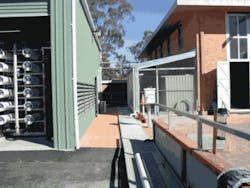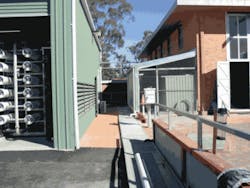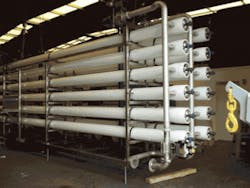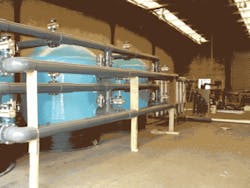Queensland’s First Municipal Desalination Plant
Successful inland Australia brackish water treatment operation prompts additional desalination plant to treat produced water piped in from coal gas recovery operation.
By Ian Cameron and Terry Fagg
A new reverse osmosis (RO) membrane desalination plant has been hailed as a prototype for other municipal authorities. Located miles inland, it treats brackish groundwater from bores. The product water is then blended with groundwater and treated water from a nearby river.
Dalby is a town of about 10,000 people in the middle of the Darling Downs region of southern Queensland, Australia. About 160 km from the coast, it’s surrounded by flat, fertile plains. The nearby Condamine River is the most significant watercourse for miles. The town’s economy focuses largely on agriculture, agricultural services and agricultural machinery, with area crops such as cotton grown under irrigation.
Since the early 1960s, Dalby enjoyed a fine, reliable water supply from a scheme based on groundwater, with surface water from Loudoun Weir 1 on the Condamine River incorporated for peak-demand supply and emergency backup. Traditionally, the groundwater has come from a relatively large number of shallow alluvial bores adjacent to the river. Apart from chlorination, this water required no further treatment for potable use, whereas the river water must be clarified and filtered before chlorination.
To counter a drop in output from the bores over many years, more bores were sunk to maintain or increase capacity. In the mid-’90s, though, it was recognized the aquifers were being depleted faster than they could recharge. Although the Loudoun Weir capacity was doubled and an increased allocation obtained, the weir’s reliability remained at only 50% of this allocation annually. The surface water treatment plant was used increasingly to meet base load demands, but the weir’s low reliability meant the town often had to reduce bore supply and impose water restrictions. And bore water quality was declining at a rate similar to its output.
Team Recommends Desalination
In 1999, Dalby Town Council contracted PB, formerly Parsons Brinckerhoff, to help it find new ways of meeting the town’s future water needs. Work was started on a water supply options study. Sixteen options were identified, including stormwater recycling, wastewater recycling, a new weir, off-stream storage, desalination and a regional pipeline.
Of these, it was determined a desalination plant that would treat brackish groundwater from bores was the most reliable and cost-effective option. This conclusion was supported by follow-up groundwater and feasibility studies. Ultimately, the council accepted a package of options that included demand management and supply-side infrastructure.
PB recommended a desalination plant of about 20 L/sec (315 gpm) capacity. The product water would be blended at the water treatment plant with groundwater and treated water from the Condamine River. Once council decided to proceed with the plant’s construction, the firm was responsible for preparing design-build tender documents, and preparing and administering the contract.
Given the project’s scale, three membrane filtration technologies that remove ions from solution were under consideration – RO, nanofiltration (NF) and electrodialysis reversal (EDR). RO and NF are variations with RO offering the highest purification. With EDR, the polarity of the electrodes is reversed from electrodialysis, in which ions are transferred through a membrane from a less concentrated to a more concentrated solution as a result of the passage of direct electric current. The result is the direction of ion movement in a membrane stack is reversed.
A tender process was used to finalize the method of desalination used. No tenders were received for NF or EDR, and the final decision was to build an RO membrane desalination plant.
Raw Water Quality Review
An important factor in selecting a desalination process and designing a desalination plant is the quality of the inflow stream, so samples were collected regularly from selected feed water bores and sent for comprehensive testing that included elements associated with fouling, such as calcium, iron, manganese and silica (soluble and colloidal). The water quality data collected from Bore 10, which was to provide the largest portion of water to be treated, indicated:
- Raw water was low in turbidity and color.
- It also was highly mineralized and well above the recommended maximum total dissolved solids (TDS).
- Total hardness and chloride concentration were above acceptable limits for potable water.
- Iron and manganese were levels were not significant.
- pH was generally between 7.2 and 7.7.
- Silica concentration was about 30 mg/L.
Two more parameters determined useful in the design of desalination plants are hydrogen sulfide (H2S) and silt density index (SDI). Processing bore water high in H2S through desalination can increase its concentrations and convert this substance to a gas; however, field tests at Bores 10, 11 and 12 showed H2S levels to be well below acceptable limits.
SDI provides an indication of the likelihood of feed water to cause fouling of a membrane. It’s not tested by general laboratories in Australia, so Dalby Town Council obtained a methodology and performed the tests onsite by exposing a 0.45 micron (µm) filter to the feed water under pressure and then calculating filtration rates. An SDI of less than 5 is considered acceptable for RO systems, although there are exceptions when an SDI of less than 3 is desirable due to the nature of the suspended solids in the feed water.
The SDI tests for Bores 10 and 11 indicated feed water was highly likely to cause membrane fouling. In Bore 10, increasing time that the pumps ran prior to sampling appeared to result in a decreasing SDI. Therefore, the continuous running of pumps to supply the desalination plant was seen as a probable way to reduce the tendency for membranes to become fouled. Bore 12 was constructed the same month much of this testing was performed, so only very limited water quality data was available.
It was noted Mn and Fe bacteria were identified in the raw groundwater from bores in the region, including nearby bores at Dalby, and that these should be taken into account in the plant design. Pretreatment was recommended which was likely to be as important as the desalination process itself, as the correct pretreatment process train would maximize the recovery ratio, optimize product water quality, and protect desalination components, including the RO membranes.
Pilot Plant Trials
After tenders were opened but before the contract was awarded, the client purchased and operated a pilot plant for about six months to reduce uncertainty related to the levels of silica, barium sulfate, and silt in the water samples and their potential to either cause scaling and fouling of the RO membranes or limit the possible recovery to an unacceptably low figure.
The process train used was considered to have a significant chance of success, but avoided high reliance on chemicals for Pretreatment pH adjustment and complex/ expensive systems. The plant had an output of 5.5 L/min (1.5 gpm) and operated at around 80% recovery. Pretreatment was provided by a multimedia filter, followed by 5 µm and 1 µm cartridge filters. Flocon 260 anti-scalant was dosed at around 6 mg/L.
The RO unit was designed to simulate the last two membranes in a full-scale plant because these are the ones most likely to be subjected to scaling. This condition was simulated by using only two membranes, but recycling the concentrate stream at a high rate from the last membrane back to the first. Daily monitoring and regular trend analysis indicated no apparent scaling problems.
The higher SDIs detected in initial testing fell to acceptable levels once the bore had stabilized after a few hours of operation. This phenomenon was noted during laboratory testing and continuous operation of the pilot plant, and Bore 12 proved that this was the case.
The multimedia filter proved invaluable for removing colloidal matter and precipitated iron. Backwash frequency based on non-stop operation was every two to three days. Five-micron cartridge change-out based on a maximum pressure differential of about 100 kpa was 600-700 hours of operating time. Membranes needed to be cleaned only about every three months.
Conclusion
The Dalby Desalination Plant has been operating successfully since it’s commissioning in the fall of 2004. The plant has become increasingly important as a water supply source for the town with the current drought affecting Eastern Australia. It requires quarterly clean-in-place (CIP) cleaning, and the cost of water produced is $ 0.55/kl, and overall recovery rates of 80%.
As a result, PB has been commissioned by Dalby Town Council to complete the design and tender documentation for a 24km pipeline from the Tipton West coal seam gas field to the Dalby Water Treatment Plant, and a new 4ml/day of permeate desalination plant to treat the 5,000 TDS coal seam gas by-product water, or brackish groundwater.
The new desalination plant, which will operate in parallel with the State 1 plant, has attracted funding from the state and federal governments, as well as Arrow Energy, the owner of the Tipton West gas field, as the project is innovate in that a by-product water will be put to beneficial use for a municipal supply. WWI
Authors’ Notes:
With 20 years in water supply and sewage treatment, Ian Cameron is PB’s water executive in Brisbane, Australia. He has worked on and designed facilities across Queensland, and completed a number of studies on infrastructure planning and water resources. In 1998, he was awarded a Churchill Fellowship for research on biological removal of waterborne contaminants.
Terry Fagg is Dalby Town Council’s technical supervisor for water supply and sewerage.



